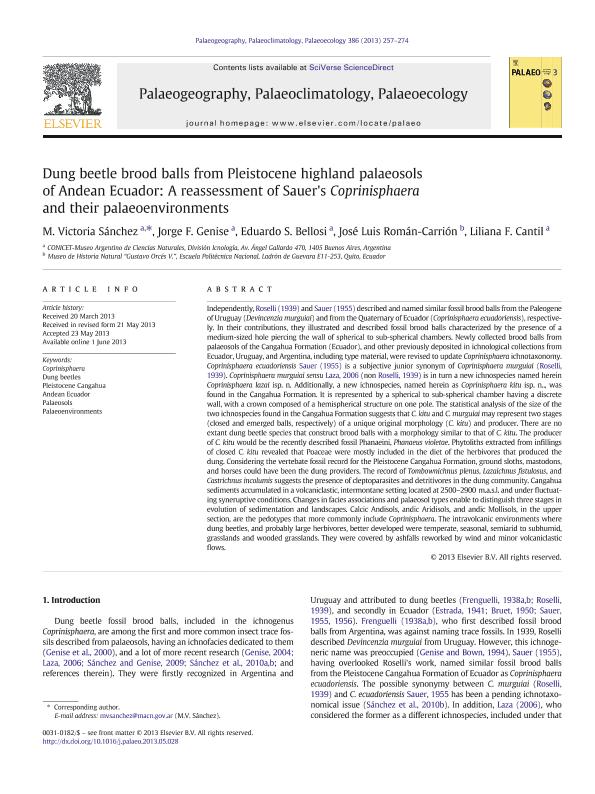Mostrar el registro sencillo del ítem
dc.contributor.author
Sánchez, María Victoria

dc.contributor.author
Genise, Jorge Fernando

dc.contributor.author
Bellosi, Eduardo Sergio

dc.contributor.author
Román Carrión, Jose Luis
dc.contributor.author
Cantil, Liliana Fernanda

dc.date.available
2016-12-02T18:25:42Z
dc.date.issued
2013-06-01
dc.identifier.citation
Sánchez, María Victoria; Genise, Jorge Fernando; Bellosi, Eduardo Sergio; Román Carrión, Jose Luis; Cantil, Liliana Fernanda; Dung beetle brood balls from Pleistocene highland palaeosols of Andean Ecuador: A reassessment of Sauer's Coprinisphaera and their palaeoenvironments; Elsevier Science; Palaeogeography, Palaeoclimatology, Palaeoecology; 386; 1-6-2013; 257-274
dc.identifier.issn
0031-0182
dc.identifier.uri
http://hdl.handle.net/11336/8695
dc.description.abstract
Independently, Roselli (1939) and Sauer (1955) described and named similar fossil brood balls from the Paleogene of Uruguay (Devincenzia murguiai) and from the Quaternary of Ecuador (Coprinisphaera ecuadoriensis), respective- ly. In their contributions, they illustrated and described fossil brood balls characterized by the presence of a medium-sized hole piercing the wall of spherical to sub-spherical chambers. Newly collected brood balls from palaeosols of the Cangahua Formation (Ecuador), and other previously deposited in ichnological collections from Ecuador, Uruguay, and Argentina, including type material, were revised to update Coprinisphaera ichnotaxonomy. Coprinisphaera ecuadoriensis Sauer (1955) is a subjective junior synonym of Coprinisphaera murguiai (Roselli, 1939). Coprinisphaera murguiai sensu Laza, 2006 (non Roselli, 1939) is in turn a new ichnospecies named herein Coprinisphaera lazai isp. n. Additionally, a new ichnospecies, named herein as Coprinisphaera kitu isp. n.., was found in the Cangahua Formation. It is represented by a spherical to sub-spherical chamber having a discrete wall, with a crown composed of a hemispherical structure on one pole. The statistical analysis of the size of the two ichnospecies found in the Cangahua Formation suggests that C. kitu and C. murguiai may represent two stages (closed and emerged balls, respectively) of a unique original morphology (C. kitu) and producer. There are no extant dung beetle species that construct brood balls with a morphology similar to that of C. kitu. The producer of C. kitu would be the recently described fossil Phanaeini, Phanaeus violetae. Phytoliths extracted from infillings of closed C. kitu revealed that Poaceae were mostly included in the diet of the herbivores that produced the dung. Considering the vertebate fossil record for the Pleistocene Cangahua Formation, ground sloths, mastodons, and horses could have been the dung providers. The record of Tombownichnus plenus, Lazaichnus fistulosus, and Castrichnus incolumis suggests the presence of cleptoparasites and detritivores in the dung community. Cangahua sediments accumulated in a volcaniclastic, intermontane setting located at 2500–2900 m.a.s.l. and under fluctuat- ing syneruptive conditions. Changes in facies associations and palaeosol types enable to distinguish three stages in evolution of sedimentation and landscapes. Calcic Andisols, andic Aridisols, and andic Mollisols, in the upper section, are the pedotypes that more commonly include Coprinisphaera. The intravolcanic environments where dung beetles, and probably large herbivores, better developed were temperate, seasonal, semiarid to subhumid, grasslands and wooded grasslands. They were covered by ashfalls reworked by wind and minor volcaniclastic flows.
dc.format
application/pdf
dc.language.iso
eng
dc.publisher
Elsevier Science

dc.rights
info:eu-repo/semantics/openAccess
dc.rights.uri
https://creativecommons.org/licenses/by-nc-sa/2.5/ar/
dc.subject
Interandean Valley
dc.subject
Paleosols
dc.subject
Pyroclastic Loess
dc.subject
Cangahua Formation
dc.subject
Dung Beetles
dc.subject
Paleoenvironments
dc.subject.classification
Geociencias multidisciplinaria

dc.subject.classification
Ciencias de la Tierra y relacionadas con el Medio Ambiente

dc.subject.classification
CIENCIAS NATURALES Y EXACTAS

dc.title
Dung beetle brood balls from Pleistocene highland palaeosols of Andean Ecuador: A reassessment of Sauer's Coprinisphaera and their palaeoenvironments
dc.type
info:eu-repo/semantics/article
dc.type
info:ar-repo/semantics/artículo
dc.type
info:eu-repo/semantics/publishedVersion
dc.date.updated
2016-11-22T21:10:39Z
dc.journal.volume
386
dc.journal.pagination
257-274
dc.journal.pais
Países Bajos

dc.journal.ciudad
Amsterdam
dc.description.fil
Fil: Sánchez, María Victoria. Consejo Nacional de Investigaciones Científicas y Técnicas. Oficina de Coordinación Administrativa Parque Centenario. Museo Argentino de Ciencias Naturales; Argentina
dc.description.fil
Fil: Genise, Jorge Fernando. Consejo Nacional de Investigaciones Científicas y Técnicas. Oficina de Coordinación Administrativa Parque Centenario. Museo Argentino de Ciencias Naturales; Argentina
dc.description.fil
Fil: Bellosi, Eduardo Sergio. Consejo Nacional de Investigaciones Científicas y Técnicas. Oficina de Coordinación Administrativa Parque Centenario. Museo Argentino de Ciencias Naturales; Argentina
dc.description.fil
Fil: Román Carrión, Jose Luis. Museo de Historia Natural "Gustavo Orcés V."; Ecuador
dc.description.fil
Fil: Cantil, Liliana Fernanda. Consejo Nacional de Investigaciones Científicas y Técnicas. Oficina de Coordinación Administrativa Parque Centenario. Museo Argentino de Ciencias Naturales; Argentina
dc.journal.title
Palaeogeography, Palaeoclimatology, Palaeoecology

dc.relation.alternativeid
info:eu-repo/semantics/altIdentifier/url/http://dx.doi.org/10.1016/j.palaeo.2013.05.028
dc.relation.alternativeid
info:eu-repo/semantics/altIdentifier/url/http://www.sciencedirect.com/science/article/pii/S0031018213002617
Archivos asociados
